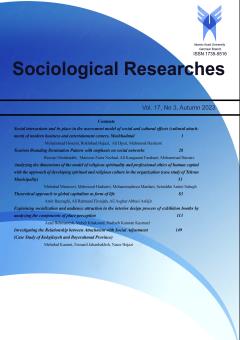-
-
List of Articles
-
Open Access Article
1 - Social interactions and its place in the assessment model of social and cultural effects (cultural attachment) of modern business and entertainment centers, Mashhadmal
سید محمد حسینی رخشاد حجازی سید علی جوزی سید محمود هاشمی -
Open Access Article
2 - An analysis of the tourism destination branding model with an emphasis on social networks with a sociological approach
Rezvan Omidzadeh Mansour Zarra Nezhad Ali Kangarani Farahani Mohammad Hemati -
Open Access Article
3 - Analysis of dimensions of religious spirituality culture model and professional ethics of human capital with the approach of developing spiritual organizational culture in the organization (case study of Tehran Municipality Organization)
mhrdad mansori Seyed mhmod hashmi mohamad reza mardani zein alabedin amini sabegh -
Open Access Article
4 - theoretical introduction to global capitalism as a form of life
Amir Razzaghi Ali Rahmani Firozjah Ali Asghar Abbasi Asfajir -
Open Access Article
5 - Explaining socialization and audience attraction in the interior design process of exhibition booths by analyzing the components of place perception
Azad Behmanesh Mehdi Khakzand Hadiseh Kamran Kasmaei -
Open Access Article
6 - Investigating the Relationship between Attachment with Social Adjustment(Case Study of Kohgiluyeh and Boyerahmad Province)
Mehrdad Karami Esmaeil Jahanbakhsh سید ناصر حجازی
-
The rights to this website are owned by the Raimag Press Management System.
Copyright © 2021-2025







